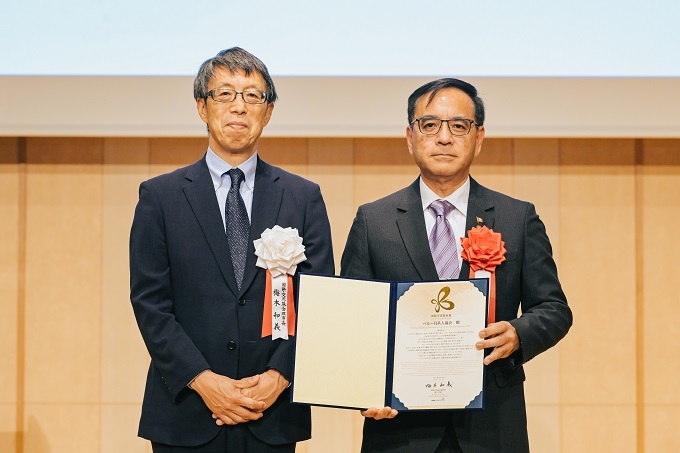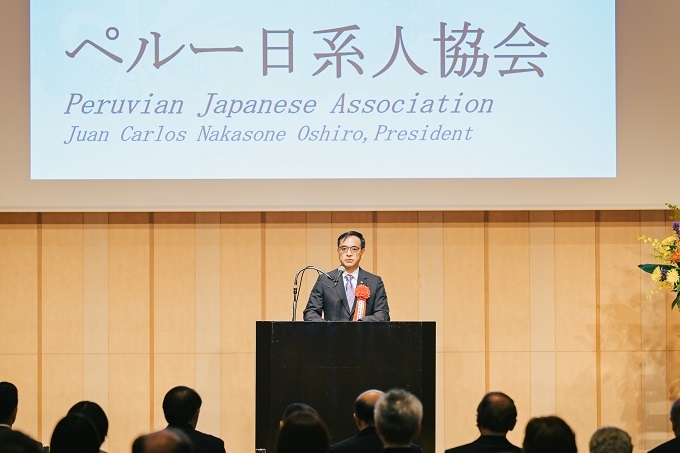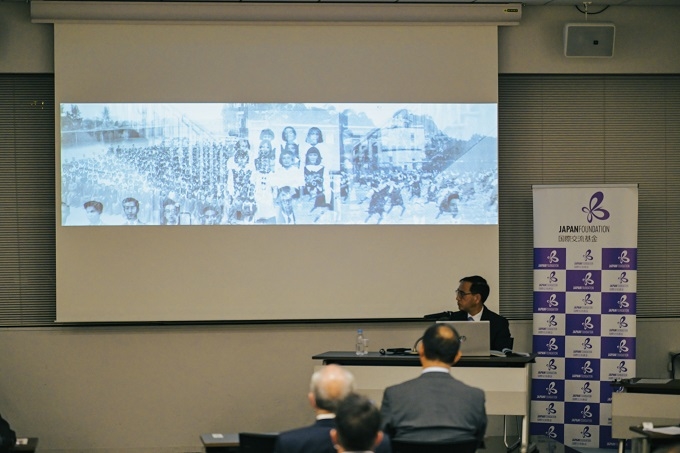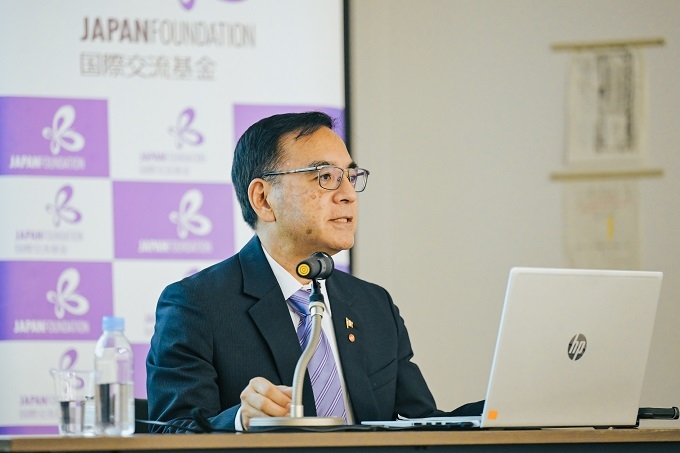The 50th Japan Foundation Awards
―Culture Transcending Borders― <4>
Peruvian Japanese Association - Award Commemorative Lecture
May 24, 2024
【Special Feature 080】
Special Feature: The 50th Japan Foundation Awards ―Culture Transcending Borders―(for summary on special features, click here)
Since its founding in 1917, the Peruvian Japanese Association (APJ) has worked to support mutual assistance between ethnic Japanese and promote their integration into Peruvian society. This year marks the 150th year of diplomatic relations between Japan and Peru and the 124th year since the start of immigration. Against this backdrop, Mr. Juan Carlos Nakasone Oshiro from the APJ, which has supported the ethnic Japanese community in Peru for many years, delivered a lecture on the history of Japanese immigration to Peru, the contributions made by the APJ, as well as its history.
The lecture can be viewed on the Japan Foundation's official YouTube channel (English subtitles available).
 The Japan Foundation's President Umemoto Kazuyoshi (left) and APJ President Nakasone at the Japan Foundation Awards Presentation Ceremony (October 18, 2023)
The Japan Foundation's President Umemoto Kazuyoshi (left) and APJ President Nakasone at the Japan Foundation Awards Presentation Ceremony (October 18, 2023)
History of the Nikkei Community in Peru
We, the Peruvian Nikkei community, are a bridge connecting both shores of the Pacific. We take great pride in inheriting the millennial traditions of Peru and Japan. Today, in this lecture, I would like to briefly explain the history of Japanese immigration and the activities carried out by the Japanese Peruvian Association for the Nikkei community and the entire Peruvian society.
This year, 2023, marks the memorable 150th anniversary of the establishment of diplomatic relations between Peru and Japan. The historical event marked the history of both countries,
giving rise to a bond that eventually led to immigration. In search of a better life, thousands of Japanese people immigrated to Peru. Peru was a temporary residence where they worked for a while to save money, intending to return to Japan. However, the situation turned out significantly different from the initial plans. What was supposed to be a short chapter in individual histories ended up leaving a significant footprint in the history of Peru. Please now watch this video created to commemorate the 120th anniversary and to summarize the history of Japanese immigration in Peru.
(See 05:30 to 09:00 of the video)
 President Nakasone expressing his pleasure at receiving the award at the Japan Foundation Awards Presentation Ceremony
President Nakasone expressing his pleasure at receiving the award at the Japan Foundation Awards Presentation Ceremony
The history of Japanese immigration can generally be divided into five periods. The era of contract immigrants from 1899 to 1923, the era of Yobiyose (summoned) immigrants from 1924 to 1939, the era of difficult times from 1940 to 1952, the era of the revival of the Peruvian Nikkei community from 1953 to 1980, and the period from 1981 to the present day in the Peruvian Nikkei community.
We are approaching the 125th anniversary since the arrival of the first Japanese immigrants to Peru. This became possible through the Japan-Peru Treaty of Amity, Commerce, and Navigation, a provisional agreement signed in Tokyo on August 21, 1873. At the end of the 19th century, Japan pursued modernization and opened its doors to Western countries. In the process, many young Japanese individuals began considering emigration overseas in search of a better future. On the opposite side of the Pacific, Peru needed a large workforce for the development of its sugar industry. Therefore, both governments allowed the entry of Japanese laborers into Peru.
The Morioka Immigration Company began advertising to attract immigrants to Peru. This company contracted 790 young Japanese people, and on February 28, 1899, they departed from Yokohama Port on the ship Sakura Maru. The first group of immigrants originated from Niigata, Yamaguchi, Hiroshima, Okayama, Tokyo, and Ibaraki. After a 34-day voyage, the Sakura Maru arrived at the port of Callao on April 3, 1899. The next day, the immigrants were left at a port near the contracted farm, and the voyage continued. The last group of immigrants was dropped off at the port of Cerro Azul in Cañete Province, south of Lima. The 790 men had signed contracts to work on coastal hacienda farms in Peru for four years. The employment conditions required individuals to be between 20 and 45 years old and in good health. Under their contracts, the working hours were set at 10 hours per day, and the wages were specified in the contracts, but in reality, they often worked over 12 hours, and there was no guarantee that the agreed-upon wages would always be paid. Many immigrants escaped from the hacienda farms, crossing the desert to head toward cities in search of a better environment. Some were caught along the way or even died.
Subsequently, in 1903, a second group of contract immigrants arrived, this time including women and children. The number of immigrants expanded, and by the end of the contract immigration in 1923, a total of 18,727 Japanese people had arrived through 82 voyages. After the end of their contracts, many Japanese immigrants sought new opportunities and moved to urban areas.
Just five years after the start of immigration in 1904, there was already one Japanese-owned beauty salon in Lima, and by 1907, 25 salons had opened. The immigrants quickly transitioned from being farmers to establishing and running their own family-owned businesses. The community of Japanese immigrants who migrated from rural areas to the city showed a strong momentum in establishing businesses such as bodegas (grocery stores), cafes, bazaars, tailors, restaurants, and beauty salons.
Another important characteristic of the Japanese immigrants was their organizational strength. With it, they were able to expand into new territories. Groups of merchants and prefectural associations (kenjinkai) were formed, recognizing the strength that comes from cooperation and mutual support. The first Japanese organization in Peru was the Lima Beauticians Association, established in 1907. Subsequently, various associations were established, including those of shopkeepers and restaurant owners.
The immigrants realized that associations based on professions were insufficient, and they were well aware of the risks of having numerous independent associations without interconnection. They recognized the need for an organization that would encompass the entire Japanese community in Peru. And in 1917, the Central Japanese Society (Chuo Nihonjinkai), now known as the Peruvian Japanese Association, was established.
And as families grew, concerns for the education of their children also arose. Education was a crucial issue for Japanese immigrants. Many people hoped for a fundamental Japanese-style education in Peru to be capable of continuing their studies in Japan.
Up until World War II, there were 50 Japanese schools scattered across 15 cities in Peru, which included coastal, mountainous, and jungle areas. These schools followed the curriculum of Japan for their education. The first Japanese school was located at Hacienda Santa Bárbara - Cañete, on the central coast of Peru. The school was founded in 1908 by the venerable monk Taian Ueno.
In 1920, Lima Nihonjin Shogakko, known as Lima Nikko for short, was established. It was the largest Japanese school in Peru. Lima Nikko had around 1,800 students and 50 teachers.
In 1921, Lima Nikko held the first undokai (sports festival) in the history of Japanese immigrants in Peru, and this tradition has been passed down as part of the Peruvian Japanese community to this day. We will now watch a video of the undokai from 1939. Let's take a moment to appreciate those times.
(See 15:04 to 18:15 of the video)
From 1924 to 1939, Peru continued to accept Japanese immigrants. Rather than labor contracts, Japanese people who settled in Peru utilized the Yobiyose (summoning) system to bring their families from Japan. They became sponsors for their families, providing financial proof of their ability to support them. New family businesses needed reliable employees, and brothers, nephews, and relatives were ideal for this purpose. The term Yobiyose came to symbolize a broad social network in which Japanese people helped each other. Many people who stayed in agricultural areas, mainly renting land, had a significant impact on Peru's agricultural production.
In commemoration of Peru's 100 years of independence, the Japanese community, as a gesture of gratitude to the country that welcomed them, donated the monument of Inca Manco Cápac, and the unveiling took place in 1926. In 1935, in commemoration of the 400th anniversary of Lima's founding and as an expression of gratitude, the Central Japanese Society donated "Pool Nippon" to Peru. It was the first Olympic-sized pool in Peru.
Despite having assimilated into Peru, intense anti-Japanese sentiments began in the early 1940s. The outbreak of World War II triggered rumors that Japan, with the cooperation of immigrants, was planning to invade Peru. On May 13 and 14, 1940, mobs armed with sticks and stones attacked Japanese-owned shops and buildings, but the Lima police did not take action to protect us. The involvement of the United States in World War II had a significant impact on the Japanese community in Peru. The Peruvian government considered itself an ally of the US and implemented regulatory policies against the Japanese community. In 1942, Peru severed diplomatic relations with Japan. The Peruvian government froze Japanese institutions' and citizens' funds, closed the consulate and the Central Japanese Society, shut down community newspapers, and confiscated Japanese schools, including Lima Nikko shown in the photo. The Peruvian government sent Japanese and their descendants, including those who were already Peruvian citizens and Nisei (second generation), to American internment camps.
After the war ended, the Nikkei community regained tranquility, but at the same time, the hope of returning to their homeland was lost. Many families chose to embrace Peruvian customs and culture more deeply.
During this period, new associations were established, and associations that were closed during the war, such as the Central Japanese Society, resumed their activities in 1953. During this period, enthusiastic Nisei youth began to make significant advances in various sports, arts, and academic fields in Peru. This photo is of the Serenade Orchestra formed in 1961. It was the first musical Nikkei group.
One of the significant events during this period was the establishment of the Asociación Estadio La Unión (AELU) in 1953 on a 100,000 square meter site in the Pueblo Libre district. It has become a place for encounters, family gatherings, and sports. In 1955, the Japan-Peru Women's Association (Fujinkai) was established. One of its pillars is social assistance activities. In the same year, the Central Japanese Society resumed its activities following the war. President Fernando Belaunde Terry decided to transfer 10,000 square meters of land in compensation for the seizure of Japanese schools during World War II.
On August 18, 1965, the first cornerstone of the Japan-Peru Cultural Center was laid on the land. The construction of the Peru-Japan Cultural Center was realized through the efforts of the Japanese government, Japanese companies, and the Nikkei community in Peru. In May 1967, with the presence of Prince Akihito, Princess Michiko, and President Fernando Belaunde, the Peru-Japan Cultural Center was inaugurated. In 1974, in commemoration of the 100th anniversary of diplomatic relations between Peru and Japan, a Japanese garden and tea house located in the exhibition park in the heart of Lima were donated to the city of Lima as a new symbol of friendship.
Currently, the number of Peruvian Nikkei is estimated to be 200,000, spanning approximately seven generations. Among this diversity, efforts are being made to connect the new generations with the land and culture of their ancestors. On April 3, 1989, in commemoration of the 90th anniversary of Japanese immigration to Peru, President Alan Garcia designated this day as Japan-Peru Friendship Day. Peru is the only country that has designated a day to celebrate friendly relations with Japan.
Due to the economic crisis, in the 1980s, many Nikkei sought new jobs and migrated from Peru to Japan, a phenomenon known as "dekasegi." Subsequently, in the 1990s, many of them returned home, but a considerable number of individuals also settled in the community, contributing to strengthening the bonds between both countries.
 President Nakasone explaining the history of Japanese immigrants in Peru at the Award Commemorative Lecture (October 20, 2023)
President Nakasone explaining the history of Japanese immigrants in Peru at the Award Commemorative Lecture (October 20, 2023)
The Nikkei community is part of Peru's ethnic and cultural diversity, contributing to various fields such as gastronomy, education, arts, and culture, leaving lasting footprints that continue to endure. I will now briefly introduce these contributions and their main representatives.
Cuisine is also a space where encounters and cultures blend. Japanese people first incorporated Peruvian ingredients into traditional Japanese cuisine (Washoku). Japanese cuisine in Peru encouraged the consumption of seafood, which was not widely eaten by Peruvians. In the field of literature, the talent of poet Jose Watanabe stands out. He consistently distanced himself from contemporary trends and incorporated thoughtful acts reminiscent of traditional Japanese poetry, such as haiku, into his works. Next is Augusto Higa. In his novels and short stories, he depicted popular districts in Lima, focusing on immigrants from the Andes, and of African descent, and the Nikkei Peruvian community, representing the voices of his generation of Nikkei in Peruvian literature. Tilsa Tsuchiya marked an era with her mysterious and dreamlike works filled with an enigmatic atmosphere. Her work "Tristan and Isolde" is the most expensive Peruvian painting ever sold in history. Venancio Shinki has also presented highly innovative works. He expresses elements of childhood and landscapes through his paintings, attempting to return to his origins. Nikkei such as Luis Abelardo Takahashi, a composer of Creole music, Angelica Harada, a singer of Andean ethnic music, and Cesar Ychikawa, a classical rock singer, have been active in various fields, such as music. There is also Olga Shimasaki, the former director and dancer of the Peru National Ballet, and Akio Tamashiro, a Pan American champion and world runner-up karate-ka in the kata discipline.
I would like to introduce three Japanese individuals who recently arrived in Peru and have made significant contributions to Peruvian society. Firstly, Yoshitaro Amano, the founder of the Amano Museum, who loves the ancient civilization of Peru and boasts one of the finest textile art collections in Peru. And Akira Kato, who served as the coach of the volleyball national team and led the team to the highest international level, becoming one of the most memorable coaches in Peru's sports history. Then Toshiro Konishi, the first Japanese chef residing in Latin America to be honored by the Japanese government for contributing to the promotion of Japanese culture and gastronomy.
Currently, there are four Nikkei schools in Peru, two of which survived World War II: Colegio Jose Galvez del Callao, established in 1926 and formerly known as Callao Nihonjin Shogakko, and Colegio Santa Beatriz - Jishuryo, established in 1928. Then in 1948, Colegio La Victoria was established, along with Colegio La Union in 1971. These Nikkei educational institutions promote the Japanese language and traditions, providing education to the general population in Peru.
I will now briefly talk about the Peruvian Japanese Association (APJ), where I serve as the president. The APJ is a non-profit organization that operates in the fields of welfare support
and cultural promotion, providing educational and insurance services. The APJ is an organization that brings together and represents the Peruvian Nikkei community, serving as a central institution. Its mission is to lead the strengthening of the Nikkei community and contribute to the development of Peru, conveying its legacy and fostering collaboration among the various organizations that make up the Nikkei system. Its vision is to be a modern, self-sustaining organization under visionary leadership, that solidifies the identity, unity, and prosperity of the Nikkei community, and contributes significantly to the prosperity of Peru. Let us now watch a video summarizing APJ's main activities and areas of operation.
(See 28:45 to 36:23 of the video)
 President Nakasone discussing the activities of the APJ, which has supported the ethnic Japanese community in Peru for many years
President Nakasone discussing the activities of the APJ, which has supported the ethnic Japanese community in Peru for many years
Cultural promotion is one of the main objectives of APJ. Every year, we organize various activities, such as exhibitions, conferences, literary competitions, book introductions,
music and theater festivals, film festivals, etc. The Peru-Japan Cultural Center has contributed to cultural promotion for over 56 years. In the facility, there is an auditorium and exhibition gallery, as well as the Elena Kohatsu Library, which houses over 20,000 texts related to Japan and the Peruvian Nikkei community. We also have the Museum of Japanese Immigration to Peru "Carlos Chiyoteru Hiraoka" which exhibits various materials related to the immigration process and the formation of the Nikkei community. The Peruvian-Japanese theater, which this year marks its 30th anniversary, is one of the most modern stages in the country. We also have a dojo for practicing martial arts such as judo, karate, kendo, and aikido.
The APJ also has an editorial fund through which it publishes various publications. Our fund published the first Spanish translation of The Tale of Genji. In 2023, we will publish two Spanish editions of classical Japanese literature: The Diary of Izumi Shikibu and The Diary of Sanuki no Suke. We also have a research fund to promote the study and analysis of the Nikkei community and its history.
In the past, the APJ has organized joint campaigns with Nikkei institutions to support vulnerable populations or during situations such as natural disasters affecting Peru. The APJ is attentive to the welfare of all members of the Nikkei community, especially the elderly, through the Ryuichi Jinnai Recreational Center.
The APJ offers comprehensive training programs that include courses and workshops, occupational career training, and specialization courses, which promote personal growth and encourage entrepreneurship in areas such as artistic expression, handicrafts, cooking, etc. In particular, we encourage the study of Japanese language and Japanese arts such as manga, ikebana, furoshiki, and origami.
The Japanese Language Promotion Department of APJ organizes a nationwide Japanese speech contest every year and supports the Japanese Embassy and the Japan Foundation in conducting the JLPT in our facilities. Furthermore, language promotion programs are conducted through workshops and school visits, as well as through the production of new collectible audio stories.
The APJ has two institutions that provide medical services, one of which is the Japanese Peruvian Polyclinic. Established in 1981, it offers outpatient services for over 30 medical specialties, providing accessible consultations to more than one million people annually at affordable prices. The Japanese Peruvian Centennial Clinic was established in 2005, offering outpatient and inpatient treatments across more than 40 medical specialties, with plans also underway for the construction of a new clinic tower. Both institutions also foster scientific research, organizing an international medical course each year, which is considered one of the most significant events in the country's healthcare sector.
All of these activities are carried out by dedicated leaders who work voluntarily without compensation. The APJ Board of Directors consists of 20 members. The organization has grown through the efforts of its officers and employees, of which there are currently over 1,600.
This year, I have the honor of leading this association, just like my grandfather did 41 years ago.
Lastly, I would like to share with you one last video starring Tony Succar, APJ's Goodwill Ambassador, who is a renowned musician and winner of 2 Latin Grammys and who together with his mother, Mimy, combined Japanese and Latin music in this new version of Sukiyaki (ue o muite arukou) together with Nora Suzuki, the vocalist of Orquesta de la Luz.
(See 40:56 to 46:08 of the video)
Thank you for watching this wonderful video. This concludes my presentation, but before we move on to the Q&A session, I would like to express my gratitude to the Japan Foundation for providing such a wonderful opportunity to reveal the history and journey of the Peruvian Nikkei community and the APJ. Thank you.
Related Articles
Related Events
Keywords
Back Issues
- 2025.6.24 Exclusive Interview:…
- 2025.5. 1 Ukrainian-Japanese I…
- 2024.11. 1 Placed together, we …
- 2024.5.24 The 50th Japan Found…
- 2024.5.24 The 50th Japan Found…
- 2024.5. 2 People-to-People Exc…
- 2024.2.19 Movie Theaters aroun…
- 2024.2.19 Movie Theaters aroun…
- 2023.4.24 The 49th Japan Found…
- 2022.10.24 Inner Diversity <2> …

